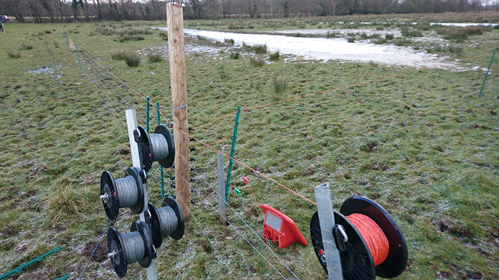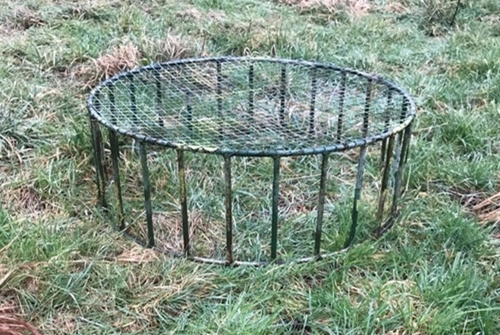Improving wader productivity is key to the recovery on Avon Valley populations. Part of our hotspot approach is to investigate the use of temporary electric fencing and other non-lethal predator exclusion methods.
Electric fencing
Electrified-exclusion fencing is a method often deployed in wetland nature reserves, though this is typically a permanent structure with high maintenance costs. The potential use permanent fencing is limited in the Avon Valley, due to its high cost, an inability to manage flooding and livestock/grazing concerns. We are trialling a system of temporary fencing, erected prior to the lapwing breeding season to exclusion terrestrial predators and improve wader breeding success.
The fenced areas are selected based on several different factors:
- A field area previously used by breeding lapwing and redshank
- New habitat features that will be used to nest/rear chicks
- An area where we will not affect grazing
- An area that will not affect farm access or processes
- Access near to the field to bring in equipment

Fences are put out in late February as birds are beginning to return to the site, the fences are set in a structured and efficient manor so that we cause as little disturbance as possible during this key time. Our lead ecologist closely monitors the birds before, during and after this procedure. Once in place, fences are typically checked and maintained at least once a week.
In 2017, two of the electric fences were erected on one hotspot site and these fences enabled fledging of chicks from one field for the first time since the start of the project. The fences were put around the new habitat feature (scrapes in the centre of the field), with the combined provisioning of good brood rearing habitat and the electric fence dramatically increasing chick survival. A total of 1,231m of electric fences was used across all hotspots to protect 30,497m² of wader breeding habitat in 2017. In spring 2018 we were able to put out seven temporary electric fences giving an overall perimeter of 3146m and protecting 81660 m² of breeding wader habitat. They were installed in locations based on previous nesting and chick foraging sites and around new habitat features. As these areas were naturally low lying, it meant that they were some of the first areas to flood in the extreme weather seen in early April 2018. This increased our fence maintenance time to make sure they were effective in time for when the waters retreated.
Nest Protection Cages
Nest protection cages (below) are a method of increasing nest survival by restricting the access of predators to active nests. This method has been used for conserving lowland breeding wader populations elsewhere in Europe. A Swedish trial at three grazed pasture sites found that nests protected with cages had significantly higher average daily survival rates than unprotected nests for both redshank and lapwing. However, this study did suggest the possibility of higher adult predation rates on adult redshank and possible increased nest abandonment of Lapwing though these effects were no statistically significant. This was of concern to our team, though increasing nest survival is important for achieving recovery.
In 2015 and 2016, nest protection cages were trialled on a limited number of nests by our lead project ecologist on randomly selected lapwing nests following a strict method of slowly introducing the cage with the birds under intensive observation during this period.
Unfortunately, found that lapwing in the Avon Valley did not readily accept the nest cages, this alongside baited trials by our predator management team meant this work was not continued. With increased effort being placed on the use of electrified-predator exclusion fencing.
